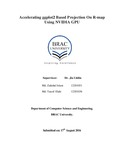| dc.contributor.advisor | Uddin, Dr. Jia | |
| dc.contributor.author | Islam, Md. Zahidul | |
| dc.contributor.author | Elahi, Md. Tausif | |
| dc.date.accessioned | 2016-09-08T09:38:35Z | |
| dc.date.available | 2016-09-08T09:38:35Z | |
| dc.date.copyright | 2016 | |
| dc.date.issued | 8/17/2016 | |
| dc.identifier.other | ID 12201051 | |
| dc.identifier.other | ID 12201036 | |
| dc.identifier.uri | http://hdl.handle.net/10361/6398 | |
| dc.description | Cataloged from PDF version of thesis report. | |
| dc.description | Includes bibliographical references (page 44-45). | |
| dc.description | This thesis report is submitted in partial fulfillment of the requirements for the degree of Bachelor of Science in Computer Science and Engineering, 2016. | en_US |
| dc.description.abstract | With an increasing amount of user and data demands for fast data processing, the optimization of database operations continues to be a challenging work. A common optimization technique is to leverage parallel hardware architectures. With the introduction of general-purpose GPU computing, massively parallel hardware has become available within commodity hardware. To efficiently exploit this technology, we introduce the method of speculative query processing. Moreover, as the dataset grows increasingly larger, multiple-thread spatial query sometimes cannot meet the performance requirement. The concept of GPU-accelerated parallel computing turns the massive computational power of a modern graphics accelerator's shader pipeline into general-purpose computing power, as opposed to being hard wired solely to do graphical operations. In certain applications requiring massive vector operations, this can yield several orders of magnitude higher performance than a conventional CPU. R is a free software environment for graphics and statistical computing that provides a programming language and built-in libraries of mathematics operations for data analysis, statistics, machine learning and much more. R programs tend to process large amounts of data, and often have significant independent data and task parallelism. Therefore, R applications stand to benefit from GPU acceleration. This way, R users can benefit from R’s high-level, user-friendly interface while achieving high performance. Thus focusing on accelerating R computations using CUDA libraries by calling our own parallel algorithms written in CUDA from R and profiling GPU-accelerated R applications using the CUDA Profiler. | en_US |
| dc.description.statementofresponsibility | Md. Zahidul Islam | |
| dc.description.statementofresponsibility | Md. Tausif Elahi | |
| dc.format.extent | 47 pages | |
| dc.language.iso | en | en_US |
| dc.publisher | BRAC University | en_US |
| dc.rights | BRAC University thesis are protected by copyright. They may be viewed from this source for any purpose, but reproduction or distribution in any format is prohibited without written permission. | |
| dc.subject | Matrix transpose | en_US |
| dc.subject | Simple mapping | en_US |
| dc.title | Accelerating ggplot2 based projection on r-map using NVIDIA GPU | en_US |
| dc.type | Thesis | en_US |
| dc.contributor.department | Department of Computer Science and Engineering, BRAC University | |
| dc.description.degree | B. Computer Science and Engineering | |

